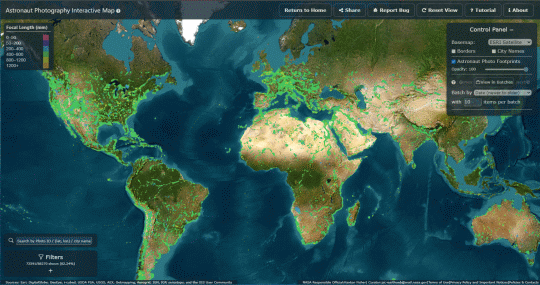ISS030-E-99324
| NASA Photo ID | ISS030-E-99324 |
| Focal Length | 400mm |
| Date taken | 2012.02.22 |
| Time taken | 19:24:00 GMT |
Resolutions offered for this image:
1000 x 648 pixels 540 x 350 pixels 720 x 480 pixels 4256 x 2832 pixels 640 x 426 pixels
1000 x 648 pixels 540 x 350 pixels 720 x 480 pixels 4256 x 2832 pixels 640 x 426 pixels
Cloud masks available for this image:
Country or Geographic Name: | UNITED ARAB EMIRATES |
Features: | DUBAI AT NIGHT, PALM JUMEIRA COMPLEX, DUBAI MARITIME CITY, BURJ KHALIFA |
| Features Found Using Machine Learning: | |
Cloud Cover Percentage: | 10 (1-10)% |
Sun Elevation Angle: | -70° |
Sun Azimuth: | 311° |
Camera: | Nikon D3S Electronic Still Camera |
Focal Length: | 400mm |
Camera Tilt: | 29 degrees |
Format: | 4256E: 4256 x 2832 pixel CMOS sensor, 36.0mm x 23.9mm, total pixels: 12.87 million, Nikon FX format |
Film Exposure: | |
| Additional Information | |
| Width | Height | Annotated | Cropped | Purpose | Links |
|---|---|---|---|---|---|
| 1000 pixels | 648 pixels | No | Yes | Earth From Space collection | Download Image |
| 540 pixels | 350 pixels | Yes | Yes | Earth From Space collection | Download Image |
| 720 pixels | 480 pixels | Yes | Yes | NASA's Earth Observatory web site | Download Image |
| 4256 pixels | 2832 pixels | No | No | Download Image | |
| 640 pixels | 426 pixels | No | No | Download Image |
Download Packaged File
Download a Google Earth KML for this Image
View photo footprint information
Download a GeoTIFF for this photo
Image Caption: City Lights of Dubai, United Arab Emirates
Note: This caption refers to the image versions labeled "NASA's Earth Observatory web site".
The City of Dubai--the largest metropolitan area within the emirate of Dubai--is a favorite subject of astronaut photography largely due to the unique island developments situated directly offshore in the Persian Gulf. These artificial archipelagos have been built such that their full design is only visible from the vantage point of an airplane - or an orbiting spacecraft such as the International Space Station (ISS). Advancements in handheld camera technology and capabilities are also improving the ISS crew's ability to capture detailed night time imagery.
The city presents an eye-catching appearance at night that vividly displays the urban development pattern. In this detailed night time image--taken with a long focal length lens and digital camera optimized for fast response and high light sensitivity--several interesting patterns can be observed. The highways and major streets are sharply defined by yellow-orange lighting, while the commercial and residential areas are resolved into a speckle pattern of individual white, blue, and yellow-orange lights. Several large and brilliantly lit areas are large hotel and mall complexes, including the Burj Khalifa Tower; at 828 meters (2717 feet) height it is the world's tallest building.
The brilliant lighting of the city contrasts sharply with both the dark Persian Gulf to the northwest, and largely undeveloped and unlit areas to the southeast. Likewise, the clusters of lighting in the Palm Jumeira complex at image top left correspond to the relatively small part of the archipelago that has been developed. Isolated areas of blurred city lights are due to patchy clouds.
Note: This caption refers to the image versions labeled "NASA's Earth Observatory web site".
The City of Dubai--the largest metropolitan area within the emirate of Dubai--is a favorite subject of astronaut photography largely due to the unique island developments situated directly offshore in the Persian Gulf. These artificial archipelagos have been built such that their full design is only visible from the vantage point of an airplane - or an orbiting spacecraft such as the International Space Station (ISS). Advancements in handheld camera technology and capabilities are also improving the ISS crew's ability to capture detailed night time imagery.
The city presents an eye-catching appearance at night that vividly displays the urban development pattern. In this detailed night time image--taken with a long focal length lens and digital camera optimized for fast response and high light sensitivity--several interesting patterns can be observed. The highways and major streets are sharply defined by yellow-orange lighting, while the commercial and residential areas are resolved into a speckle pattern of individual white, blue, and yellow-orange lights. Several large and brilliantly lit areas are large hotel and mall complexes, including the Burj Khalifa Tower; at 828 meters (2717 feet) height it is the world's tallest building.
The brilliant lighting of the city contrasts sharply with both the dark Persian Gulf to the northwest, and largely undeveloped and unlit areas to the southeast. Likewise, the clusters of lighting in the Palm Jumeira complex at image top left correspond to the relatively small part of the archipelago that has been developed. Isolated areas of blurred city lights are due to patchy clouds.


